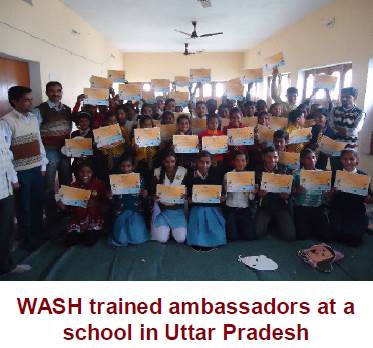|
Water,
Sanitation and Hygiene (WASH) W ater, sanitation and hygiene issues are a big challenge facing schools in the developing world. An estimated 1.9 billion school days could be gained if the Millennium Development Goals (MDGs) relating to safe water supply and sanitation are achieved and the incidents of diarrhoea illness are reduced.1 One way of achieving this is by providing schools with safe drinking water, improving sanitation facilities and hygiene education which in turn would encourage development of healthy behaviour for life. This strategic approach is known as Water, Sanitation and Hygiene (WASH) education. While there are many approaches based on various cultural insights and environmental and social realities, any WASH intervention in schools should include the following2:• Sustainable, safe water supply points, hand-washing stands and sanitation facilities; • Fully integrated life skills education using participatory teaching techniques, focusing on key hygiene behaviour for school children and; • Awareness and outreach activities at the household and community level |
|
"Lack of sanitation is a reliable marker of how the poorest in a country are faring," said Sanjay Wijesekera, Head of UNICEF’s Global Water, Sanitation and Hygiene (WASH) programmes. "Although it is the poor who overwhelmingly do not have toilets, everyone suffers from the contaminating effects of open defecation, so everyone should have a sense of urgency about addressing this problem." Source: Press release from UNICEF on World Toilet Day 19 November 2014 |
|
Development Alternatives (DA) under its programme area of Basic Need Fulfilment focuses on the provision of clean drinking water and sanitation facilities through setting up of community and enterprise delivery models. DA has conducted extensive research and innovated technologies to address issues relating to water quality. The approach used includes the following: • Multi-stakeholder processes for access to basic needs goods and services • Capacity building of service delivery agents and other stakeholders • Advocating for a supportive policy regime to enhance fulfilment of basic needs for all • Innovation in finance and business models and enterprise incubation for delivery of products and services to provide outreach at scale One of our latest initiatives has been the ‘WASH in
schools’ project supported by Jochnick Foundation (2012-2014) where safe
water, sanitation and hygiene needs of the children have been a • Leveraging funds by the schools to build ownership and engagement • Motivating students to build a sense of pride and dignity regarding personal health and hygiene • Infrastructure and campaign design and implementation • Setting up of community /school owned institutional systems The Jocknick ‘WASH in schools’ initiative has used the approach code called the 4 A’s approach (Assessment, Awareness, Action and Advocacy). This initiative first pre-‘Assessed’ gaps and needs to understand the prevailing WASH concerns in schools. ‘Awareness’ was then interwoven with real-time use of the infrastructure provided. Children and school authorities ‘Acted’ to ensure sustainability of this initiative. The children also ‘Advocated’ for behaviour change amongst their families and communities through campaigns for extended impact. By supporting good health, hygiene and dignity at this formative stage in a child’s life, the ‘WASH in schools’ initiative has yielded multiple dividends such as reduction in the school drop-out rate especially of the girl children; promotion of gender equality by building sanitation structures separately for the girls; and sensitisation of the community to take action towards demanding safe water and toilet facilities. This pilot initiative has demonstrated that each child can effectively reach and influence 50 individuals in her/his community essentially reaching about 10 households. With over 60 per cent of India’s population lacking access to sanitation facilities, the ripple effect created by bringing awareness among school children can be very effective in creating a healthy, gender equal and developed India. q Dr. Alka Srivastava References 2 Water Sanitation and Hygiene in Schools UNICEF: a companion to the Child Friendly Schools Manual http://www.unicef.org/publications/files/CFS_WASH_E_web.pdf
|
 ddressed
at the school level. The focus of this project has been in two states in
India, namely Uttar Pradesh and Madhya Pradesh. The following components
have been used in its design and implementation:
ddressed
at the school level. The focus of this project has been in two states in
India, namely Uttar Pradesh and Madhya Pradesh. The following components
have been used in its design and implementation: